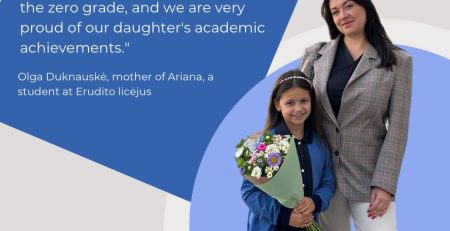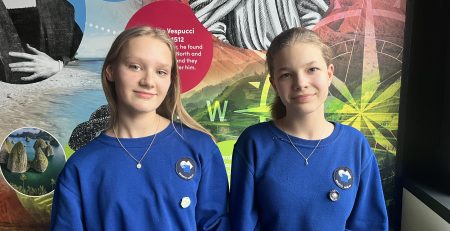Dr. Nerijus Pačėsa: virtual reality and artificial intelligence – newcomers in the classroom that teachers will have to learn to manage
The educational experts gathered at the “Shaping the future of learning” conference are as united as ever – digital educational content, virtual reality, artificial intelligence (AI) solutions will soon become commonplace, rather than surprising in schools. Maybe next year you won’t send an email to teacher to find out how your child is doing in math because you will be taken to the AI-powered learning platform and receive a detailed report on your child’s achievements there.
Silent helper artificial intelligence
Out of the abundance of innovations, two prevailing and at first glance even contradictory trends to each other can be singled out. The first is the dramatic increase in the supply of quality digital content. It is not just the transfer of printed textbook material to the digital space – such a method has long ceased to be new, but rather hygiene. Today, this content is becoming much more advanced – it is interactive and can be used on smart boards, tablets and other devices. The student can get more involved in it, have a certain learning relationship: mark, change, fill in, etc. In addition, more and more content based on AI solutions is appearing in Lithuania. What does this mean for the teacher and the student? First of all, it means more independent learning opportunities for the student. AI algorithms adapt tasks according to the student’s abilities, speed, and knowledge. Once you start solving the tasks, the AI recognizes which ones are doing better, so it gives fewer tasks or makes them more difficult, and vice versa – where it is difficult, it gives more additional tasks. It is clear that AI will profoundly change learning. Until now, it was up to the teacher to differentiate the tasks, and it is natural that it is very difficult to do this qualitatively when working with a large class. AI algorithms cope with this task quickly and reliably – the learning content is adapted to the abilities and knowledge of each student. This trend is very prominent and as far as its future is concerned, it is clear that it will soon dominate. Therefore, we should already think about how schools can adapt to AI innovations and make use of them. Also, to prepare and help teachers to take advantage of new opportunities, to control the resulting apprehensions or fears about the future of their workplace.
Lesson in Mars
Another type of digital content that is increasingly used for education is virtual reality. While it’s still mostly entertainment-based content, all signs point to it making a big inroad into the educational environment as well. Using virtual reality glasses with learning content, you can move to another continent, planet, simulate certain processes of organisms, inspect the structure of a plant from the inside, etc. It will become an integral part of the curriculum in natural and biological sciences. For now, there is not much of this content in Lithuanian, its development is hampered by the need to have special equipment, but in the future, students will visit virtual worlds more than once during lessons. A simpler solution to this content is augmented virtual reality, where you can use simpler equipment, e.g. mobile phones. Special apps create 3D images that appear right in the classroom. For example, in history lessons, you may see historical figures that you just heard about from the teacher. This content is still more of an entertainment nature, but in natural sciences, chemistry, physics, where various tests need to be simulated, it can make an important breakthrough.
Between reality and virtuality
The rapid development of digital content is one of the aforementioned two opposing trends. Who opposes it and why? It is most strongly opposed to experiential subjects that require a direct interface, e.g. arts, literature, philosophy. Their representatives are wary of this trend, seeing the threat that students will lose sociality, their relationship with reality and move to the virtual world. These criticisms, by the way, are not completely unfounded. Various formats of experiential methods are becoming a counterweight to the virtual world. Entertainment for many students is digital – today’s young people do less sports, exercise, and socialize. The school becomes a place that can intervene and bring children back to reality with its different cognitive possibilities. Therefore, in the future we will see a greater supply of experiential formats and niche schools, e.g. nature, arts, schools without classrooms, etc. Creative, visual thinking (design thinking, visual thinking) methods are already becoming popular. They are basically meant for students to touch real things and create something themselves.
Although the digital and experiential trends are partly at odds with each other, both will remain important and evolve in parallel, complementing each other.
How it works in practice
In our Lyceum, we have tested all possibilities – both virtual and augmented reality, as well as AI solutions. Digital interactive content is already widely used. Its greatest value is engagement. Especially for elementary school students, it arouses interest in the subject of study, provides an emotion that helps to understand and absorb knowledge more easily. The application of AI solutions has the greatest breakthrough potential. This would help to solve the already mentioned extremely important task of education – to differentiate and individualize the content for each student. This is a difficult task for any teacher, for any school, because it requires a lot of individual attention for the student, which is extremely difficult to give to everyone during the lesson. The biggest problem with digital content and AI solutions is that it is difficult to ensure the continuity of content in the Lithuanian language. The material is still fragmentary, covers only some topics, more like a demo version in English language. There have been quite a few such solutions for some time, and as translation technologies develop, more quality content in Lithuanian appears. As soon as it is possible to ensure the continuity of this content, the correspondence to school programs, the breakthrough will be big. The decisive turning point may happen next year as well.














